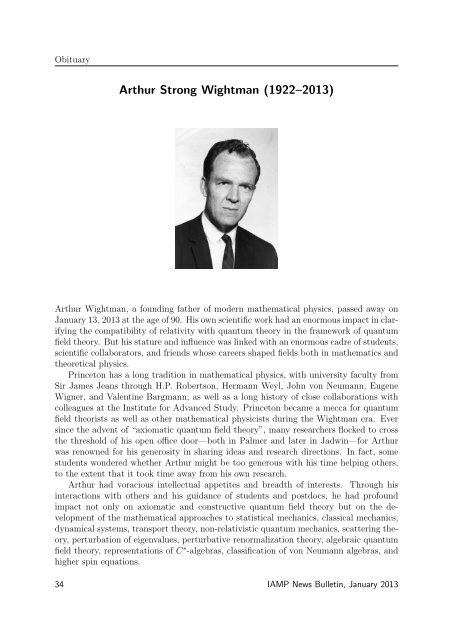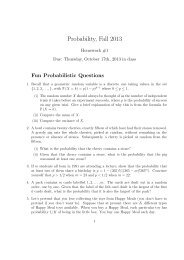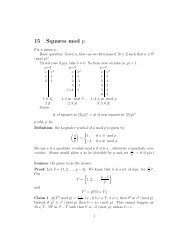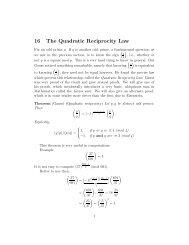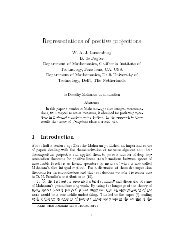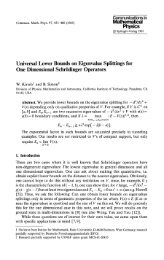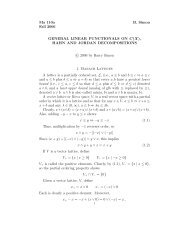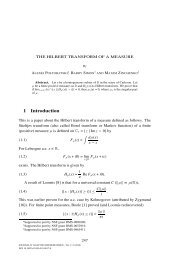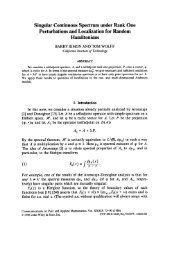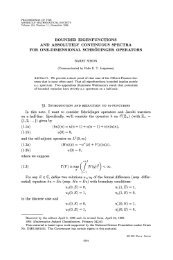Arthur Strong Wightman (1922–2013) - Mathematics Department
Arthur Strong Wightman (1922–2013) - Mathematics Department
Arthur Strong Wightman (1922–2013) - Mathematics Department
Create successful ePaper yourself
Turn your PDF publications into a flip-book with our unique Google optimized e-Paper software.
Obituary<br />
<strong>Arthur</strong> <strong>Strong</strong> <strong>Wightman</strong> (<strong>1922–2013</strong>)<br />
<strong>Arthur</strong> <strong>Wightman</strong>, a founding father of modern mathematical physics, passed away on<br />
January 13, 2013 at the age of 90. His own scientific work had an enormous impact in clarifying<br />
the compatibility of relativity with quantum theory in the framework of quantum<br />
field theory. But his stature and influence was linked with an enormous cadre of students,<br />
scientific collaborators, and friends whose careers shaped fields both in mathematics and<br />
theoretical physics.<br />
Princeton has a long tradition in mathematical physics, with university faculty from<br />
Sir James Jeans through H.P. Robertson, Hermann Weyl, John von Neumann, Eugene<br />
Wigner, and Valentine Bargmann, as well as a long history of close collaborations with<br />
colleagues at the Institute for Advanced Study. Princeton became a mecca for quantum<br />
field theorists as well as other mathematical physicists during the <strong>Wightman</strong> era. Ever<br />
since the advent of “axiomatic quantum field theory”, many researchers flocked to cross<br />
the threshold of his open o ce door—both in Palmer and later in Jadwin—for <strong>Arthur</strong><br />
was renowned for his generosity in sharing ideas and research directions. In fact, some<br />
students wondered whether <strong>Arthur</strong> might be too generous with his time helping others,<br />
to the extent that it took time away from his own research.<br />
<strong>Arthur</strong> had voracious intellectual appetites and breadth of interests. Through his<br />
interactions with others and his guidance of students and postdocs, he had profound<br />
impact not only on axiomatic and constructive quantum field theory but on the development<br />
of the mathematical approaches to statistical mechanics, classical mechanics,<br />
dynamical systems, transport theory, non-relativistic quantum mechanics, scattering theory,<br />
perturbation of eigenvalues, perturbative renormalization theory, algebraic quantum<br />
field theory, representations of C ⇤ -algebras, classification of von Neumann algebras, and<br />
higher spin equations.<br />
34 IAMP News Bulletin, January 2013
Obituary<br />
<strong>Wightman</strong> was known for his honesty and his adherence to the highest scientific standards,<br />
attributes that he tried to communicate to whoever crossed his path. His lectures<br />
in Princeton were legendary for their careful planning and for content that included constant<br />
attempts to integrate the latest research directions into his courses. Behind the<br />
scenes, <strong>Wightman</strong> worked tirelessly to encourage Princeton to accept the most talented<br />
undergraduates, to improve and to preserve Princeton’s famous library of mathematics<br />
and physics, and to create a research atmosphere in the department that stimulated<br />
outstanding work.<br />
<strong>Arthur</strong> <strong>Wightman</strong> also helped shape the future far beyond Princeton. His summer<br />
school lectures in Varenna, Les Houches, and Cargèse consolidated or opened up new<br />
directions in mathematical physics. During the 1963–64 academic year, <strong>Arthur</strong> joined<br />
Hans Borchers, Harry Lehmann, Henri Epstein, and Jurko Glaser to help the IHES<br />
founder Leon Motchane and Louis Michel establish a program in mathematical physics.<br />
(The IHES had just moved from Paris to Bures-sur-Yvette.) In 1973, Giorgio Velo and<br />
<strong>Arthur</strong> <strong>Wightman</strong> began their own series of productive summer schools in Erice.<br />
<strong>Arthur</strong> encouraged the founding and later served as an associate editor of Communications<br />
in Mathematical Physics, as well as editing book series for Benjamin and for<br />
Princeton Press. <strong>Arthur</strong> had a compelling interest in the history of science as seen, for<br />
example, in the long introduction to Robert Israel’s book on the history of convexity in<br />
physics. As a member of the board of Princeton Press, he was a key earlier supporter<br />
in getting the Einstein Papers project under way. <strong>Arthur</strong> was the editor of Wigner’s<br />
complete works published by Springer.<br />
<strong>Arthur</strong> was born in Rochester, New York on March 30, 1922 and served in the US<br />
Navy after graduation from Yale in 1942. He then started graduate school in physics at<br />
Princeton intending to work with Eugene Wigner, but since Wigner was spending most<br />
of his time then at Oak Ridge, <strong>Wightman</strong> wrote a Ph.D. thesis on The Moderation and<br />
Absorption of Negative Pions in Hydrogen under John Wheeler, also with input from<br />
his old mentor, Robert Marshak in Rochester. <strong>Arthur</strong> spent the rest of his academic<br />
career at Princeton, eventually as Thomas D. Jones Professor of Mathematical Physics<br />
jointly in <strong>Mathematics</strong> and Physics. During 1951–52 and 1956–57 he visited Copenhagen,<br />
where he interacted strongly with scientists in nearby Lund, especially with Gunnar<br />
Källén in physics and with Lars G˚arding in mathematics. With the latter, he framed the<br />
mathematical foundations for the quantum field theory axioms that bear their names.<br />
<strong>Arthur</strong>’s honors include the 1969 Heineman Prize for Mathematical Physics, 1970<br />
election to the US National Academy of Sciences, 1976 Gibbs Lectureship, and a 1997<br />
Poincaré Prize.<br />
<strong>Arthur</strong> married Anna-Greta Larsson, who was a talented artist and photographer.<br />
Anna-Greta, as well as their daughter Robin, died from cancer at a young age. <strong>Arthur</strong>’s<br />
second wife of thirty-five years, Ludmilla Popova <strong>Wightman</strong>, translates poetry from Bulgarian<br />
to English. She and his stepson, Todor Todorov, survive him.<br />
<strong>Arthur</strong> was a pivotal figure in the emergence of modern mathematical physics in the<br />
50’s and 60’s. In order to mark his passing, the flag of Princeton University flew at half<br />
mast for three days.<br />
IAMP News Bulletin, January 2013 35
Obituary<br />
This (certainly incomplete) list of <strong>Arthur</strong> <strong>Wightman</strong>’s students is a compilation from<br />
several sources, though it relies heavily on the mathematics genealogy web site:<br />
Silvan Samuel Schweber 1952<br />
Richard Ferrell 1952<br />
Douglas Hall 1957<br />
Oscar W. Greenberg 1957<br />
Huzihiro Araki 1960<br />
John S. Lew 1960<br />
William Stanley Brown 1961<br />
James McKenna 1961<br />
Peter Nicholas Burgoyne 1961<br />
John Dollard 1963<br />
Eduard Prugovecki 1964<br />
<strong>Arthur</strong> Ja↵e 1966<br />
Oscar Lanford, III 1966<br />
Anton Capri 1967<br />
Robert Powers 1967<br />
Lawrence Schulman 1967<br />
Christian Gruber 1968<br />
Note: A website has been set up at Princeton:<br />
Jerrold Marsden 1968<br />
Gerald Goldin 1969<br />
Eugene Speer 1969<br />
George Svetlichny 1969<br />
Barry Simon 1970<br />
Charles Newman 1971<br />
Stephen Fulling 1972<br />
Robert Baumel 1979<br />
Alan Sokal 1981<br />
Vincent Rivasseau 1982<br />
Rafael de la Llave Canosa 1983<br />
Steven Bottone 1984<br />
Thea Pignataro 1984<br />
Jan Segert 1987<br />
Jay Epperson 1988<br />
Marek Radzikowski 1992<br />
Jan Westerholm 1996<br />
https://www.princeton.edu/physics/arthur-wightman.<br />
for reminiscences of <strong>Arthur</strong>. Contributions for this site can be sent to Regina Savadge,<br />
rsavadge@princeton.edu.<br />
<strong>Arthur</strong> Ja↵e and Barry Simon<br />
36 IAMP News Bulletin, January 2013


